Whiteboards are very useful tools for activity professionals, particularly with group sessions.
I hope you enjoy our whiteboard activity ideas and remember to use whiteboard markers, as permanent markers are just that! Permanent! So what can you do on a whiteboard? I have gathered a collection of our relatable content in Maria's Place, and here are some examples that you might try.
The Hangman
One of the most common whiteboard games must be “The Hangman.” (It’s great as a table-top game also) It is a guessing game and can be played with a group or with an individual.
How to play the game
One player thinks of a word, a phrase, or a sentence, and the other(s) has to guess what it is. The words have to be proper words, not names of people or places (unless you specify, for example, that the word is a capital city in the US), slang, or rude words. It makes it easier if you have a theme. For example, decide that the word is a flower, a wild animal, or food. Player 1 will draw this basic shape, and a number of short lines underneath that correspond to the number of letters in the word.
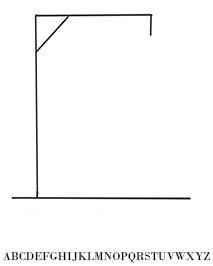 If player 2 (3, 4….in turn) guesses a correct letter, player 1 puts in its right position in the line.
If player 2 guesses an incorrect letter, a body part is added to the hanged man. The letter is also written below and crossed out to show that it has been used and that it is wrong.
If you like, you can write the whole alphabet under your hangman to make it easier for the participants to think of a letter and then just cross them out as they are used.
If the participant(s) guesses the word before the hangman is finished, they win, and if the hangman has all his body parts before they do, they lose.
You might find that people object to the image of the hanged man. If this happens, make up your own image with a set amount of parts. You could draw a vase with ten flowers that need stems added. When all the stems are added, the game is over. Or a stick Christmas tree that can have decorations added to the ends of the branches.
This is a great game for engaging the brain!
For individuals or as a one-on-one activity, print the template, explain the exercise and play the game. You can take turns being the player that thinks of the word.
Early-stage memory care/dementia or as a group activity, print and hand out the template or use the whiteboard and draw the figure and letters. If the participants find it difficult, tell them the first letter of the word and give verbal clues as to what the word might be.
If you don't want anyone to lose the game, keep adding body parts or give the man clothes until the word is guessed correctly.
If player 2 (3, 4….in turn) guesses a correct letter, player 1 puts in its right position in the line.
If player 2 guesses an incorrect letter, a body part is added to the hanged man. The letter is also written below and crossed out to show that it has been used and that it is wrong.
If you like, you can write the whole alphabet under your hangman to make it easier for the participants to think of a letter and then just cross them out as they are used.
If the participant(s) guesses the word before the hangman is finished, they win, and if the hangman has all his body parts before they do, they lose.
You might find that people object to the image of the hanged man. If this happens, make up your own image with a set amount of parts. You could draw a vase with ten flowers that need stems added. When all the stems are added, the game is over. Or a stick Christmas tree that can have decorations added to the ends of the branches.
This is a great game for engaging the brain!
For individuals or as a one-on-one activity, print the template, explain the exercise and play the game. You can take turns being the player that thinks of the word.
Early-stage memory care/dementia or as a group activity, print and hand out the template or use the whiteboard and draw the figure and letters. If the participants find it difficult, tell them the first letter of the word and give verbal clues as to what the word might be.
If you don't want anyone to lose the game, keep adding body parts or give the man clothes until the word is guessed correctly.
Download basic Hangman template here.

9 Letter squares
This is another fun whiteboard activity. You have to find as many words as possible made from the letters in the grid. Each letter may only be used once. Variations:
- Use any letter in any order to form a word of any length
- Always include the central letter in the words
- Include names
- Make words with a minimum of 3 or four letters
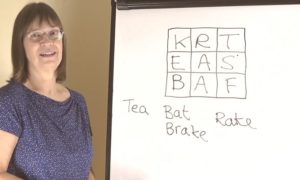 Provide the person with a printed page, pen, and paper, and explain how to do it if needed or find the words together, and give clues if needed. Maybe ask them to find words starting with a particular letter if they are stuck. This is a little easier.
When you write the words down, write in columns, each starting with the same letter. This makes it easier to see which words you have already found.
Provide the person with a printed page, pen, and paper, and explain how to do it if needed or find the words together, and give clues if needed. Maybe ask them to find words starting with a particular letter if they are stuck. This is a little easier.
When you write the words down, write in columns, each starting with the same letter. This makes it easier to see which words you have already found.
This is a good activity to do with a group. Use a large whiteboard and write their answers for all to see. Give clues as needed, and don’t limit the number of letters you can use in any word. Include names and plurals. Any recognizable word or name is OK. Finding lots of words makes the activity a success! This activity is suitable for both men and women and is both a mental exercise and a social activity if done with others. Another variation on this activity would be if you don't put a nine-letter word into the squares. Instead, ask the participants to choose the letters and add them into the squares. Just make sure you have at least three vowels in there; otherwise it can be a bit difficult.
Click here if you want to see Maria doing a video tutorial on 9-letter squares for groups. And if you would like ready, printable word squares, click here.
Memory game
Bring a bag, our residents now call it “The magic bag”, to this activity with an assortment of items in it.
Show the group the items, one at a time. Take your time and discuss each one as you produce them. Let the participants handle the objects and chat about them. If anyone has a story about a particular object, encourage them to share it. Bringing some unusual objects to the activity makes it more interesting.
Leave the items on the table where everyone can see them and let them focus on trying to remember what they are for a while. After this, cover the items with a towel and ask the group to call out what is hidden.
I usually start with seven items and write the items on the whiteboard as they are called out. That way, they can easily see what has been remembered and can focus better on what has not been said yet. When they have remembered all the items, I lift the cover, wipe the board, add another four items, and then do it again. You might need to give clues by describing items that nobody can remember, like their color, shape, size, etc., to trigger the memory. 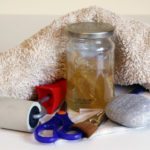 This is a fun memory exercise. It is a great opportunity for a good discussion and reminiscence with a group or individual about the items.
Some people don't have the capacity to remember more than one thing at a time. I encourage these people to pick just one item to remember. I then ask them first, after the cover goes on, so that they don't have to try and remember what it was for too long.
If one or two persons are particularly fast at remembering, I ask them to give others a chance once they have called out one item. Go back to them if the others are stuck.
This is a fun memory exercise. It is a great opportunity for a good discussion and reminiscence with a group or individual about the items.
Some people don't have the capacity to remember more than one thing at a time. I encourage these people to pick just one item to remember. I then ask them first, after the cover goes on, so that they don't have to try and remember what it was for too long.
If one or two persons are particularly fast at remembering, I ask them to give others a chance once they have called out one item. Go back to them if the others are stuck.
Anagrams
An Anagram is a word or phrase formed by rearranging the letters of a different word or phrase. For example, bet all hoses = ballet shoes, in our anagram game about different kinds of shoes. You’ll find several themed examples of printable anagram games in Maria’s Place. If you are doing this with someone else or a group and want to make this activity easier to do, underline the first letter of the correct answer to the clues. With a small group of similar cognitive ability, it usually works well playing it on a whiteboard with the group. Place the whiteboard at one end of the table so that everyone can see well and lead the activity. Make sure to use a wipeable marker. As a group activity, print the anagram for yourself, then write each scrambled word on the board for all to see and have a guess as to what the word is. Writing the theme of the words on the top of the whiteboard helps to focus the participants. Early-stage memory care/dementia; you may need to give more assistance here. You could give them (or underline) the 1st, 2nd, and so on, letter of the answer. Click here to see our printable anagrams.
Creative writing
"These hands," a Creative Writing group project.
I did a group project with six residents in St Elizabeth’s nursing home a while ago. I showed them my hands and asked them to tell me some things that their hands have done in life. I used a whiteboard so that everyone could see the suggestions that were made. It was a fun exercise, and after a good interactive session, we ended up with the piece of writing below.
These Hands
Have been very busy Have nursed babies Have planted cabbage Have done plenty of washing Have written shopping lists Have used a typewriter Have baked much bread Have made a lot of tea Have used a lawnmower Have polished many shoes Have shaken lots of other hands Have used a hammer Have driven a tractor Have sewed and knitted Have watered flowers Have picked potatoes Have played ball games Have stacked mountains of turf Have written many letters Have held other hands to give comfort If these hands could talk....... By St Elizabeth’s NH residents
To follow up on this, we painted a large background paper. 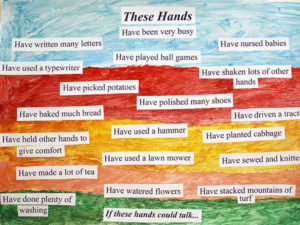 I printed out the individual lines from the poem, and the residents cut them out and glued them onto the background. We now have a permanent artwork stemming from a fun mental exercise. Many of the activities we do can become more than the initial exercise. This one involved socializing, thinking, imagination, painting, cutting, and placing objects on the background.
For more about creative writing and poetry, click here and here.
You can do creative writing with individuals or groups. Using the whiteboard ensures it is inclusive, and everyone can see what is happening.
Other themes that worked well were “I am the ocean” (city/forest) and, of course, writing about the different seasons.
I printed out the individual lines from the poem, and the residents cut them out and glued them onto the background. We now have a permanent artwork stemming from a fun mental exercise. Many of the activities we do can become more than the initial exercise. This one involved socializing, thinking, imagination, painting, cutting, and placing objects on the background.
For more about creative writing and poetry, click here and here.
You can do creative writing with individuals or groups. Using the whiteboard ensures it is inclusive, and everyone can see what is happening.
Other themes that worked well were “I am the ocean” (city/forest) and, of course, writing about the different seasons.
Lists
Using a whiteboard is a great medium for making lists, especially in group activities. You can make lists about anything. Pick something that is not too hard, as finding lots of words to put on the list makes it a more rewarding and fun activity.
For example:
- Make a list of counties in Ireland, England, states in America, etc.
- As many colors as you can think of.
- Different types of shoes.
- Hobbies that people might have.
- Different types of clothing or furniture.
Writing the theme title on the top of the board helps to focus the participants. As I have mentioned before, often in a group, there are one or two very fast people that would give all the answers if you let them. You could go around the room and ask people individually (without putting too much pressure on them if they can't think of an answer). Or say, "If you have given an answer, let others have a go before you give another." People are usually understanding.
Alphabet games
How many words can you find in each of the categories below, starting with the same letter? Choose (or get the person(s) you are with) to choose a letter of the alphabet. All the answers have to start with the chosen letter, you can have as many categories as you wish, and I give some examples below. Verbally mentioning the starting letter frequently helps to focus the participant(s). I find this a very useful game both for individuals and groups, as depending on the letter chosen; it will be different each time you do it. If some people in a group are very fast at replying, say that if you have come up with two answers, you will have to give others in the group a chance to have a go as well. You can use it over and over, choosing different starting letters each time. Even if you chose the same letter again, you will always get new suggestions. Hint: the letter B is by far the easiest to find words with in all categories.
Examples of categories:
- A girl’s name
- A boy’s name
- The last name
- An animal
- A flower
- Something you eat
- Something you drink
- Something you wear
- A body part
- Something you do regularly
- A mode of transport
- A profession
- A hobby
- A place name (state, city, local area) in your country
- A place-name abroad
- Something you find in a house
- I am sure you can come up with many more.
Alphabet Trivia
You’ll find a collection of trivia lists with different themes from A to Z in Maria’s Place. This is a really good group activity using a whiteboard. Pick your theme and try to find an example relating to that theme for each letter of the alphabet. Give hints if needed. It is absolutely fine if you miss some and don’t get them all. The object of the exercise is to have fun and encourage concentration, focus, and thinking. Exercise the little grey cells! If you are doing it using our trivia lists, try doing it without looking at the printout first, then fill in any gaps from our suggestions.
Drawing Activity
Take turns drawing something on the whiteboard, a little bit at a time. If the group is not mobile, you can do the drawing and let the group do the guessing. This doesn’t have to be competitive; sometimes it’s good just to have some fun! If you want to make it competitive, give a point to the first person to guess the answer.
Recording scores
A whiteboard is perfect if you have an activity where scores are recorded. Write the participants' names and add the scores after the names as you go.
If working with a group that has dementia (or if you just want to create more engagement), instead of just writing the names, ask the group for the names of the next person to be written down. “Who is next? How do you spell that name? etc. You want the people to be as actively involved as much as possible.
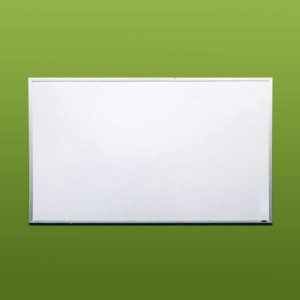 This is great for target games. If you have a person that wins all the time, vary the rules so that sometimes the highest score wins and sometimes the lowest. You could make two signs, highest score and lowest score, and pull one of them out of a hat either before or after the completion of the game. This works great in a game of darts or a ring game and makes it more of a game of chance. (You can get dart games that have magnetic darts instead of sharp points).
Let the participants help to mentally add the scores up if you are playing more than one round of a game.
This is great for target games. If you have a person that wins all the time, vary the rules so that sometimes the highest score wins and sometimes the lowest. You could make two signs, highest score and lowest score, and pull one of them out of a hat either before or after the completion of the game. This works great in a game of darts or a ring game and makes it more of a game of chance. (You can get dart games that have magnetic darts instead of sharp points).
Let the participants help to mentally add the scores up if you are playing more than one round of a game.
Using a whiteboard to show the day’s activities or menu
 Last in our lineup of Whiteboard activity ideas: Writing the day's activities, times, and where they take place helps residents or participants to know what is going on that day. Adding the date, month, and day of the week helps to focus people on time. Liven it up by using different color markers and drawing fun pictures!
Adding images of the food on the menu for that day makes it more visual and is a help for those who may not be too good at reading.
Last in our lineup of Whiteboard activity ideas: Writing the day's activities, times, and where they take place helps residents or participants to know what is going on that day. Adding the date, month, and day of the week helps to focus people on time. Liven it up by using different color markers and drawing fun pictures!
Adding images of the food on the menu for that day makes it more visual and is a help for those who may not be too good at reading.
Maria Brady
Do you have more whiteboard activity ideas? Please share in the comment section below.
Follow these links for different word games and quizzes.
We have some fun activities on YouTube if you would like to visit Maria's Place there.
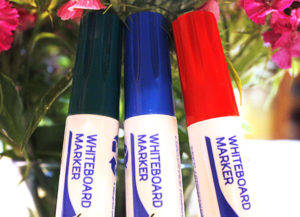






Elissa Metzke says:
I used your example of “These Hands” today with the Residents in the Facility I work in today, and once they and the staff got the idea they took off with suggestions on how they used their hands. It brought back memories and lots of laughter. Thank You for the idea.
maria says:
That’s great Elissa! I would love to see what you came up with if you would like to share.
bglonek says:
Thank you! Great ideas
[email protected] says:
We’ve been doing “These Hands” for years and it always goes so well and invokes so many conversations and memories. We draw round peoples hands and then write what they say they’ve done on the fingers and then put all the hands on a large piece of paper making a really interesting poster.
We’ve also done “ These feet” which was also brilliant.
maria says:
Thank you for sharing, Wendy. I love the way one person’s idea sparks another and creates great engagement and creativity. Maria
APKmomo says:
This is a great list of whiteboard activity ideas! I’m looking forward to trying some of them out.
Noelia Jenne says:
I want to to thank you for this very good read!! I definitely enjoyed every bit of it. I have you saved as a favorite to check out new things you post…